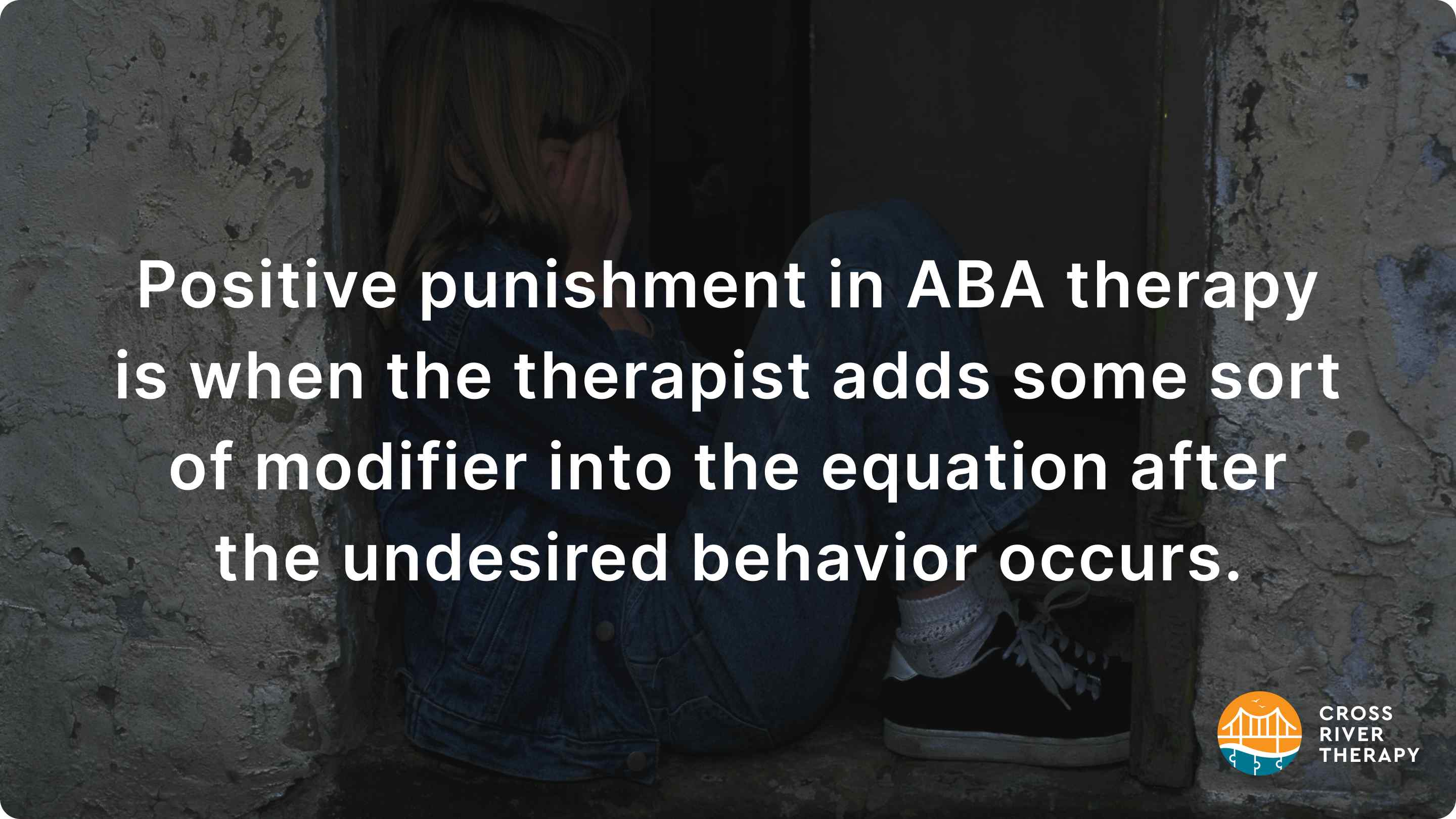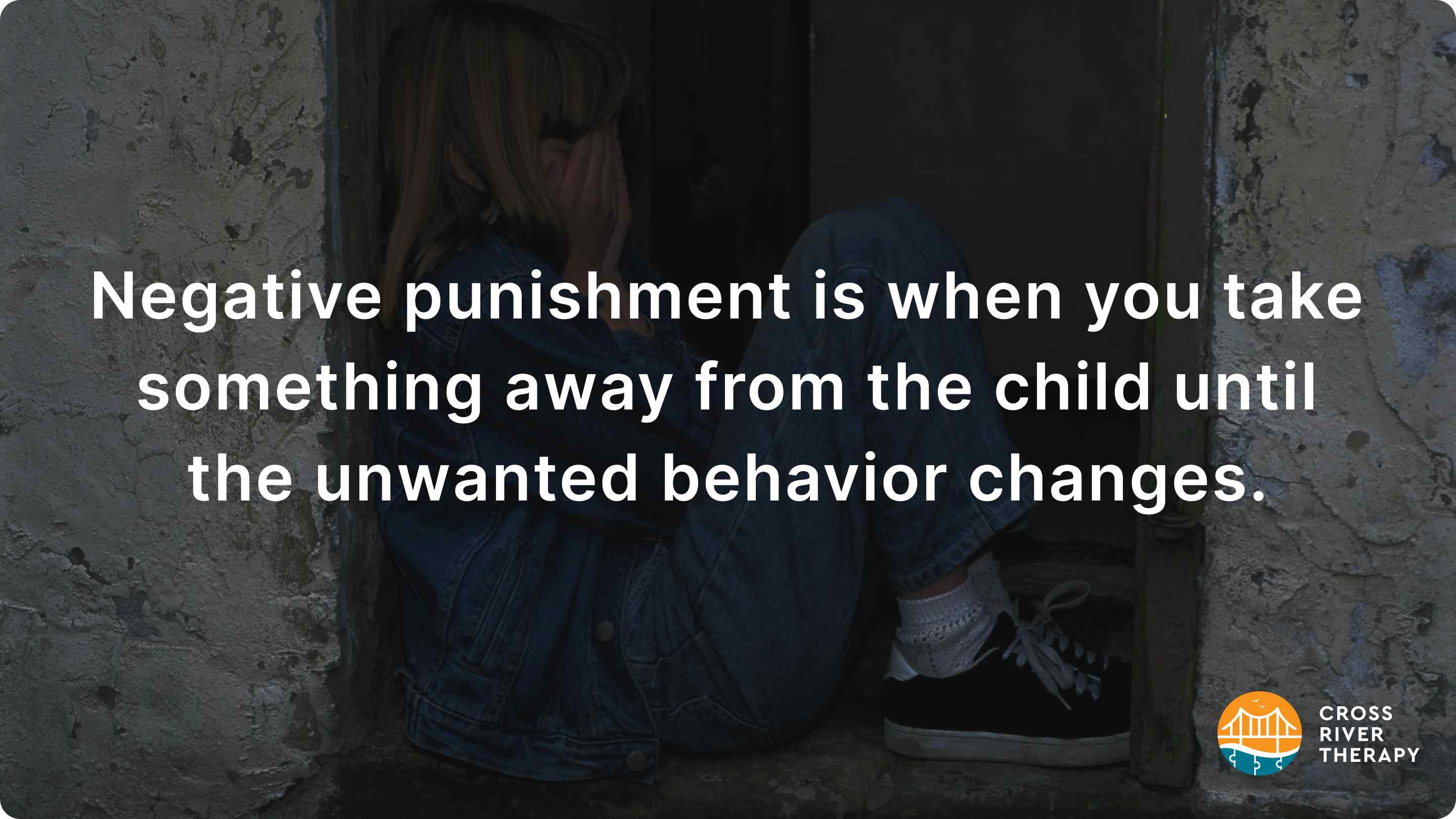Positive vs Negative Punishment in ABA Therapy
Learn the differences between positive vs negative punishment / reinforcement in ABA therapy.

Positive vs Negative Punishment
Today we'll go over the main differences between positive and negative punishment, and how you can use these two techniques to help children on the autism spectrum improve their behavior.
What is punishment in ABA therapy?
Punishment in ABA therapy is an intervention method that ABA therapists use to help get the desired behavior effect from a child during ABA therapy.

When people hear the word punishment, they often think of disciplining a child after they have misbehaved in one form or the other.
However, the word punishment when associated with ABA therapy doesn't necessarily mean the same thing.
In ABA therapy, punishment is only used as a last resort, but punishment in ABA therapy is not necessarily a bad thing.
There are two types of punishment that we will discuss in detail that is used in ABA therapy: Positive and Negative.
Neither of these types of punishments is inherently wrong or bad, but ABA therapists have to use both types with consistency and care for effectiveness.
Plus, any type of punishment should be used as a last resort if other types of reinforcement strategies have failed to work.
What is positive punishment?
Positive punishment in ABA therapy is when the therapist adds some sort of modifier into the equation after the undesired behavior occurs.

A good example of positive punishment that adults can understand is getting a speeding ticket after driving too fast.
Receiving a speeding ticket is classified as positive punishment because it is designed to make the driver, less inclined to drive faster and break the law again.
This is considered an example because the ticket is designed to help stop speeding behavior from happening again.
However, it is important to make sure that you understand that merely adding a consequence alone does not make it positive punishment.
For a consequence to be considered a viable positive punishment, it has to successfully reduce the unwanted behavior that it is triggering.
What is negative punishment?
Negative punishment is the opposite of positive punishment. It's when you take something away from the child until the unwanted behavior changes.

An easy example of negative punishment is taking away some sort of toy from the child if they are not staying on task or performing the preferred behavior.
This is taken away until the child either finishes the task or changes the behavior. The act of taking away the toy is how negative punishment is used effectively in ABA therapy.
Is positive punishment better than negative punishment?
When you start looking at the differences between positive and negative punishment, it can be difficult to figure out which one is better.
There isn't a definitive answer to which one is better because the answer could change depending on an individualized situation.
Sometimes negative punishment will not work with some children just like positive punishment also doesn't work.
The biggest thing that you need to remember, especially when working with children who suffer from autism, negative and positive punishment could cause more harm and may even be considered abusive in some cases.
When your ABA therapist starts speaking about using any of these types of punishments with your children, you should have an in-depth conversation about what to expect and to make sure that it will be a good option.
However, when negative and positive punishment are put against each other, positive punishment does have a higher track record for being more effective in improving behavior.
Most ABA therapists will go with positive punishment strategies before trying negative ones, but it doesn't mean that positive punishment will always be the best. Take the time and do research.
Positive Punishment Examples
The speeding ticket example provided above is a good example to help you understand positive punishment, but what does it look like in ABA therapy?
The ABA therapist will usually have several behaviors that they want to focus on with your child, especially if your child is suffering from autism.
When the therapist has a child working on a task or behavior, they will monitor the child and usually, there is some sort of reward put into place for the end of the session or behavior.
However, if the therapist finds that the child is off-task, they might increase the time it takes for the child to receive the reward they were promised for performing the past behavior.
By extending the time of the reward, the therapist has used positive punishment, and if it helps to keep the child on task then it would have been performed effectively.
Negative Punishment Examples
With negative punishment, the ABA therapist will take away the reward offered to the child for being on task.

This reward could be a toy or something else that the child enjoys doing.If the child is off-task, the therapist might take away the child's toy or the reward that was promised to incentivize them to adhere to the task and desired behavior.
For the most part, ABA therapists will only use negative punishment as the last response to ensure reinforcement. They will usually try and go with some form of positive punishment.
Using Positive and Negative Punishment Correctly
Using positive and negative punishment must be performed correctly for it to be effective.
Not all children will respond to this type of treatment, but if an ABA therapist does decide to use either of these methods, the chosen punishment must be applied consistently.
If it is performed inconsistently, it has proven to be ineffective. As the parent, it is important to support your therapist in their efforts to help reinforce the desired effect.
If you or the therapist strays from the paradigm at all, it could cause the child to not understand why they are being punished, which could cause a variety of other issues that before were not a problem.
Balancing Punishment and Reinforcement
Punishment and reinforcement have a lot of similarities, but they are still different strategies. Reinforcement will provide a stimulus to the child if they do the preferred behavior, like a reward.
This helps the child to make a positive recollection of performing the desired behavior. Just like with punishment strategies, therapists can use positive or negative reinforcement strategies.
Some examples of using positive reinforcement include rewarding a child after they have received a good report card.

However, it can be as little as giving positive praise to a kid who has completed a hard assignment or homework.
The reinforcement does not have to be tangible to be effective. Both punishment and reinforcement can be used in ABA therapy together, but you should understand the difference between them to ensure you understand how to use them properly and the pros and cons of what each one offers.
Using Reinforcement Properly
When using reinforcement, it is important to understand that negative reinforcement is not the same thing as punishment intervention.
Regardless of which intervention you go with, the only way for it to be effective is if everyone involved uses it consistently.
The biggest difference between the two is reinforcement should be used to increase the behavior that you want to see, while punishment is used when you want to decrease undesirable behavior.
Pros & Cons of Punishment in ABA Therapy
Although punishment is an intervention that is widely used in ABA therapy, it does come with a lot of controversies.
One of the biggest cons to using punishment is that if it is not performed consistently and properly, then the child in ABA therapy might not be capable of connecting the punishment with the behavior that you are trying to change.
However, one issue with using negative or positive punishment is that many people translate the meaning of the word punishment wrong.
They look at it negatively, but this isn't the case.Due to this, it can cause the tone of the therapy to be inaccurate and misleading, which can be difficult for a parent to come across and understand.
Pros & Cons of Reinforcement in ABA Therapy
This does not mean that reinforcement does not have its drawbacks. If the reinforcement is not done properly, it could cause the child to become dependent on the modifiers set in place, which is not a good thing.
Rather than the child learning the desired behavior, it could cause the child to only perform the behavior if they are rewarded, and it could cause them to do undesirable behaviors in response to not getting the reward.
If reinforcement isn't used consistently, it could cause the desired behavior to return and the child might relapse to who the behavior the child experienced beforehand.
If it happens, it is known by psychologists as extinction, and simply put, this means that the intended and desired behavior is in effect extinct due to the child reverting to their original behavior.
References
- https://bcotb.com/the-difference-between-positivenegative-reinforcement-and-positivenegative-punishment/
- https://positivepsychology.com/positive-punishment/
- https://www.splashlearn.com/blog/how-is-negative-reinforcement-for-kids-a-great-strategy-when-used-right/
- https://www.verywellmind.com/what-is-positive-reinforcement-2795412

Have Any Questions?
Whether you're curious about our services or need support, we're just a click away. Reach out or check our FAQs for quick answers.

